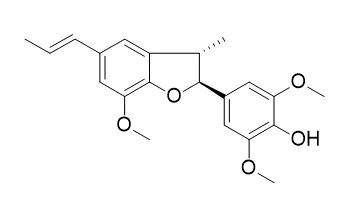| Kinase Assay: |
| Food Chem. 2016 Jul 1;202:269-75. | | New acyclic bis phenylpropanoid and neolignans, from Myristica fragrans Houtt., exhibiting PARP-1 and NF-κB inhibitory effects.[Pubmed: 26920294 ] | The bioassay-guided fractionation of the aril of Myristica fragrans (mace spice) yielded five phenolic compounds, one new acyclic bis phenylpropanoid (1) and four previously known phenolic compounds: compounds (1) (S) 1-(3,4,5-trimethoxyphenyl)-2-(3-methoxy-5-(prop-1-yl) phenyl)-propan-1-ol, (2) benzenemethanol; α-[1-[2,6-dimethoxy-4-(2-propen-1-yl)phenoxy]ethyl]-3,4-dimethoxy-1-acetate, (3) Odoratisol A, phenol, 4-[(2S,3S)-2,3-dihydro-7-methoxy-3-methyl-5-(1E)-1-propenyl-2-benzofuranyl]-2,6-dimethoxy, (4) 1,3-benzodioxate-5-methanol,α-[1-[2,6-dimethoxy-4-(2-propenyl)phenoxy]ethyl]-acetate, (5) licarin C; benzofuran,2,3-dihydro-7-methoxy-3-methyl-5-(1E)-1-yl-2-(3,4,5-trimethoxyphenyl).
METHODS AND RESULTS:
An NMR tube Mosher ester reaction was used in an approach to characterize and determine the assignment of the absolute configuration of the new isolated chiral alcohol (1). The PARP-1 inhibitory activity was evaluated for compound (1) (IC50=3.04μM), compound (2) (IC50=0.001μM), compound (4) (IC50=22.07μM) and compound (5) (IC50=3.11μM). Furthermore, the isolated secondary metabolites were tested for NF-κB and K-Ras inhibitory activities. When tested in the p65 assay, compounds (2) and (4) displayed potent NF-κB inhibition (IC50=1.5 nM and 3.4nM, respectively). |
|






 Cell. 2018 Jan 11;172(1-2):249-261.e12. doi: 10.1016/j.cell.2017.12.019.IF=36.216(2019)
Cell. 2018 Jan 11;172(1-2):249-261.e12. doi: 10.1016/j.cell.2017.12.019.IF=36.216(2019) Cell Metab. 2020 Mar 3;31(3):534-548.e5. doi: 10.1016/j.cmet.2020.01.002.IF=22.415(2019)
Cell Metab. 2020 Mar 3;31(3):534-548.e5. doi: 10.1016/j.cmet.2020.01.002.IF=22.415(2019) Mol Cell. 2017 Nov 16;68(4):673-685.e6. doi: 10.1016/j.molcel.2017.10.022.IF=14.548(2019)
Mol Cell. 2017 Nov 16;68(4):673-685.e6. doi: 10.1016/j.molcel.2017.10.022.IF=14.548(2019)